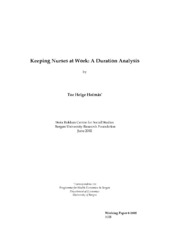| dc.contributor.author | Holmås, Tor Helge | eng |
| dc.date.accessioned | 2006-06-22T09:16:33Z | |
| dc.date.accessioned | 2020-12-10T06:33:21Z | |
| dc.date.available | 2006-06-22T09:16:33Z | |
| dc.date.available | 2020-12-10T06:33:21Z | |
| dc.date.issued | 2002-06 | eng |
| dc.identifier.issn | 1503-0946 | |
| dc.identifier.uri | https://hdl.handle.net/1956/1430 | |
| dc.description.abstract | A shortage of nurses is currently a problem in several countries, and an important question is therefore how one can increase the supply of nursing labour. In this paper we focus on the issue of nurses leaving the public health sector by utilising a unique data set containing information on both the supply and demand side of the market. To describe the exit rate from the health sector we apply a semi-parametric hazard rate model. In the estimations we correct for unobserved heterogeneity by both a parametric (Gamma) and a non-parametric approach. We find that both wages and working conditions have an impact on nurses’ decision to quit. Furthermore, failing to correct for the fact that nurses’ income partly consists of compensation for inconvenient working hours results in a considerable downward bias of the wage effect. | en_US |
| dc.format.extent | 70911 bytes | eng |
| dc.format.mimetype | application/pdf | eng |
| dc.language.iso | eng | eng |
| dc.publisher | Stein Rokkan Centre for Social Studies | eng |
| dc.relation.ispartofseries | 6-2002 | |
| dc.relation.ispartofseries | Working Paper | en |
| dc.title | Keeping Nurses at Work: A Duration Analysis | eng |
| dc.type | Working paper | eng |
| dc.subject.nsi | VDP::Samfunnsvitenskap: 200 | nob |
